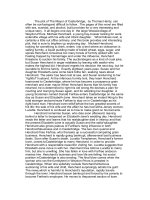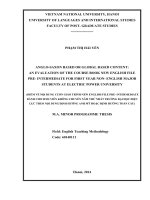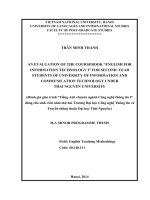SEEKING AN UNDERSTANDING OF THE GROUNDWATER AQUIFER SYSTEMS IN THE NORTHERN SACRAMENTO VALLEY
Bạn đang xem bản rút gọn của tài liệu. Xem và tải ngay bản đầy đủ của tài liệu tại đây (188.59 KB, 4 trang )
SEEKING AN UNDERSTANDING OF THE GROUNDWATER AQUIFER SYSTEMS
IN THE NORTHERN SACRAMENTO VALLEY
Allan Fulton1, Toccoy Dudley2, Kelly Staton2, Debbie Spangler2
SOUND CONCEPT OR MISCONCEPTION
To many people, the Sacramento Valley appears as an expansive groundwater basin filled with freshwater. It is also common to
conceptualize the groundwater basin as an underground lake or a series of underground rivers that provide water to wells. Are
these sound concepts or misconceptions? Recent interpretation of over 150 down-hole electrical resistivity logs from widely scattered
locations throughout much of the northern Sacramento Valley has revealed that these simplistic concepts are incorrect. This pamphlet
provides a glimpse of ongoing studies of the aquifer systems in the northern Sacramento Valley. The findings are preliminary and
will likely improve as further information is gathered. Comprehensive reports of these studies should be available later in 2004.
KNOWLEDGE GAPS AND NEW INVESTIGATIONS
Concepts are easily formed and rationalized and can appear to be factual
without sufficient field research to validate them. Until recently, only three
regional investigations of the aquifer systems in the Sacramento Valley had
been completed in the past 80 years and none were conducted since the mid
1970’s.
Since 1997, the California Department of Water Resources, Northern District,
Groundwater Section, headquartered in Red Bluff, California, has been
conducting new investigations into the saline and freshwater aquifer systems
in the northern Sacramento Valley. Findings from their investigations offer
a greater understanding of the geology and hydrogeology in the northern
Sacramento Valley.
METHODS USED IN RECENT GROUNDWATER INVESTIGATIONS
Figure 1. Northern Sacramento Valley Geologic Map. Red
lines illustrate geologic cross-sections used in
investigations of the northern Sacramento Valley aquifer
systems since 1997. The legend of corresponding geologic
map units and names is below.
CORRELATION OF MAP UNITS
2
Pliocene
Oligocene Miocene
Tertiary
Qb
Qm
Pleistocene
Quaternary
Qa
Qr
Tte
Jurassic Cretaceous
In this groundwater investigation, e-logs were gathered from numerous wells
along the section lines shown in Figure 1. Resistivity data for each well were
digitized and placed in the correct location along the cross-section line.
Holocene
Electrical resistivity logs from natural gas and water wells were used to
develop these sections. Resistivity surveys were performed in these wells
before the casing and pump were installed. A probe consisting of paired
electrodes was lowered into a borehole and an electrical current of a known
voltage was sent from one electrode through the geological formation
surrounding the borehole. The second electrode detected the drop in
electrical current after it had been conducted through the formation.
Formations with coarse gravel and sand have greater resistance to electrical
current while fine grain formations such as clay have less resistance.
Formations that contain saline water have even less resistance. Electrical
resistivity data, portrayed on an electrical log, or e-log, was recorded
continuously throughout the depth of the borehole and graphically displayed
with computer software. The data were then used to determine the depth
of various geologic formations. Geologic formations that have similar
resistivity patterns or “signatures” allow correlation of these formations
between various wells.
Eocene
Geologic cross-sections have been and are currently being developed to help
understand the sub-surface hydrogeology of the northern Sacramento Valley.
Figure 1 shows the surface geology of the northern Sacramento Valley and
location of six geologic cross-sections created during these studies. Four of
the cross-sections trend west to east. The northernmost cross-section line, AA’ runs from Flournoy to Vina. The cross-section line B-B’ ranges from Chrome
to Chico. Line C-C’ transects the area midway between Artois and Willows
and extends east to the area between Durham and Richvale. Line D-D’
follows the Glenn-Colusa County line through Princeton and extends east
into the area north of Gridley. Two north-south cross-section lines run down
each side of the valley. Line E-E’ represents an eastside transect that extends
from the foothills southeast of Vina to the Sutter Butte mountain range in
the south. Line F-F represents a west side transect that parallels I-5 near Red
Bluff in the north and ends midway between Maxwell and Williams in the
south.
Qa
Alluvium
Qb
Basin Deposts
Qm
Modesto Formation
Qr
Riverbank Formation
Tte
Tehama Formation
Ttc
Ttd
Tuscan Formation Unit D
Ttb
Ttc
Tuscan Formation Unit C
Tta
Ttb
Tuscan Formation Unit B
Tn
Tta
Tuscan Formation Unit A
Ttd
Tupv
Ti
Tlpsv
JKgvs
Tn
Neroly Formation
Tupv
Upper Princeton Valley Fill
Ti
Ione Formation
Tlpsv Lower Princeton Submarine
Valley Fill
JKgvs Great Valley Sequence
1
UC Cooperative Extension, Tehama County, 1754 Walnut Street, Red Bluff, CA 96080 (530) 527-3101
California Department of Water Resources, Northern District, 2440 Main Street, Red Bluff, CA 96080 (530) 529-7383
Figure 2 illustrates how e-log data were compared to one another to identify similarities between boreholes and to develop a
geological cross-section for each of the section lines shown in Figure 2.
Figure 2. Illustration showing how electrical logs (e-logs) are used to correlate formations and develop
geologic cross-sections.
FINDINGS FROM INVESTIGATIONS
Hydrogeology
Most people do not realize that the Sacramento Valley is primarily a saline water aquifer system, and that fresh groundwater is only
found in the upper formations. Marine formations, such as the Great Valley Sequence and the Lower Princeton Submarine Valley Fill
deposits, labeled in red in Figure 3, are the primary saline water aquifer systems in the northern Sacramento Valley. The groundwater
from these aquifer systems is highly saline and unsuitable for either domestic or agricultural use. Transitional aquifer systems such as
the Neroly Formation, Ione Formation, and Upper Princeton Valley Fill tend to contain a mixture of saline and fresh groundwater.
These units are also labeled in red in Figure 3 and contain groundwater that may or may not be suitable for various uses depending
on location.
Four major freshwater, or non-marine, formations exist in the northern Sacramento Valley. They are the Alluvial deposits, the Tuscan
Formation, units A and B, the Tuscan Formation, unit C, and the Tehama Formation. These deposits overlie the marine, or saline,
formations and are the major source of fresh groundwater to wells. These formations are shown in Figure 3, labeled in blue. The
thin red line in Figure 3 below the Tuscan Formation and the Tehama Formation, and above the Great Valley Sequence, Neroly
Formation, and Ione Formation represents the approximate contact between fresh and saline groundwater, occurring at a depth
ranging from 1500 to 3000 feet below ground surface.
Alluvial Deposits
Tuscan Fm,
Unit A
Tehama Fm
Tuscan Fm, Unit C
Tuscan Fm, Unit B
Great Valley
Sequence
Neroly Fm
Upper Princeton Valley Fill
Lower Princeton
Submarine Valley Fill
Ione Fm
Great Valley
Sequence
Figure 3. Geologic formations identified for cross-section line B-B’ (refer to Figure 1) between Chrome on the west side of the Sacramento
Valley and Chico on the east side to a depth of about 3000 feet. Surface landmarks provide orientation across the valley. The Tuscan Formation,
unit D is illustrated in the surface geology (figure 1) near Red Bluff, However, it was not encountered in this cross-section or any of the other
sections south of Red Bluff.
Freshwater Aquifer Systems
The Alluvial aquifer system is the uppermost groundwater bearing unit, reaching from ground surface to maximum depth of about
200 feet. Many domestic wells draw water from this aquifer system. In the northern Sacramento Valley, the Alluvial aquifer system
is comprised of four different subgroups, according to geologic material, location and age of the geologic material, and the different
rates each of the subgroups yield groundwater. The Alluvium, the Modesto and Riverbank Formations, and the Basin deposits are
identified as Qa, Qm, Qr, and Qb, respectively, in Figure 1.
The Alluvium is composed of gravel, sand and silt deposited along active rivers and their tributaries. Groundwater yields can be
productive from these deposits. The active gravel deposits found along Stony Creek and Thomes Creek are examples of Alluvial
deposits. The Modesto Formation consists of gravel, sand, silt and clay deposits that border existing streams on both sides of the
valley. The Riverbank Formation is composed of older gravel, sand and silt, and was deposited mainly on the west side of the valley.
Groundwater yields in the Modesto and Riverbank Formations are also productive. Basin deposits consist of low permeable clays that
usually produce little water to wells. The Butte Basin is an example of where Basin deposits occur.
The Upper Tuscan aquifer system is exposed on the east side of the valley along the foothills and is found at a depth of about 800 feet
in the central portion of the valley. This aquifer system extends west past the Sacramento River under the surface, and underlies the
Alluvial aquifer system. It consists of consolidated rocks and finer grained silts and clays formed from volcanic mud flows and yields
various rates of groundwater. Along the eastern margin of the valley, well yields in the Upper Tuscan are low. Moving westward
across the valley, the character of the Upper Tuscan changes to a more permeable water-bearing zone with groundwater production
up to 6,000 gpm (gallons per minute). The Upper Tuscan aquifer system
corresponds to the Tuscan Formation, units C and D, as shown in Figure 1.
The Lower Tuscan aquifer system is also exposed on the east side of the valley.
In the central portion of the valley, it is found at a depth of about 1000 feet
below ground surface. It lies beneath the Upper Tuscan aquifer system beginning
at the eastern foothills and extends westward past the Sacramento River
approaching Interstate 5 (see Figure 4). This aquifer system consists of gravels,
sands, and silts that typically yield high flows (2000 to 3000 gpm). Artesian
wells have been observed on the west side of this aquifer system due to the
hydrostatic pressure from up gradient recharge areas to the east. The Lower
Tuscan aquifer system corresponds to the Tuscan Formation, units A and B, as
shown in Figure 1.
The Tehama Formation aquifer system is exposed on the west side of the
Sacramento Valley, at a depth ranging from the ground surface to about 1000
feet. This formation underlies the Alluvial aquifer system to the east. The WillowsCorning Fault and the Black Butte Thrust Fault disrupt the continuity of the
aquifer system. The Tehama Formation aquifer system was formed from the
uplifting and erosion of the Coast Ranges and consists primarily of clay, sand
and gravel. Groundwater is pumped from wells in this aquifer system but well
yields and specific capacities (gpm per foot of drawdown in the well) are typically
less than those in the Tuscan aquifer systems.
Figure 4. Buried extent of Lower Tuscan aquifer system
The geologic cross-section (B-B) displayed in Figure 3 is representative of the
in the northern Sacramento Valley.
other east-west cross-section lines (A-A,‘ C-C,‘ and for the most part D-D‘) . The
Tuscan aquifer systems are evident on the east side of the valley beginning near Red Bluff and extend as far south as Little Dry Creek
in Butte County. Investigations along section line E-E’ reveal slightly different geology, beginning at Little Dry Creek and extending
south to the Sutter Buttes. Another aquifer system, the Sutter Formation aquifer system, overlies the Upper and Lower Tuscan
aquifer systems. The Sutter formation originates at the base of the Sutter Buttes mountain range and forms an apron surrounding
the Sutter Buttes that extends northward towards Little Dry Creek. On the west side of the valley, the Tehama aquifer system
consistently extends from Red Bluff southward past Maxwell and Williams into
the Southern Sacramento Valley.
VALUE OF UNDERSTANDING THE AQUIFER SYSTEMS
The hydrogeology illustrated in Figure 3 is complex, involving both saline and
freshwater aquifer systems. These systems do not align well with county
jurisdictions. As county governments and residents pursue local management to
protect and manage groundwater, the geology of the aquifer systems suggests
that cross-county coordination may eventually be necessary. It also suggests that
groundwater monitoring should be in place for specific aquifer systems. Figure 4
illustrates the buried extent of the Lower Tuscan aquifer system. Understanding
the extent of this potentially productive aquifer system is important to ensure
that it is managed in the future to achieve a balance between preservation and
utilization. Figure 5 shows postulated recharge areas for the Lower Tuscan aquifer
system. Interestingly, some critical recharge areas appear to be along the foothills
of the Cascade range. Ultimately, an improved understanding of the northern
Sacramento Valley groundwater system protects against misconceptions from being
taken as fact and identifies where further research is needed to continue to improve
our understanding and management ability.
Figure 5. Some postulated recharge areas for the
Lower Tuscan system.
RELATED NORTHERN SACRAMENTO VALLEY GROUNDWATER REFERENCES
! Kirk Bryan, USGS Water Supply Paper 495. Published 1923
! USGS Water Supply Paper 1497, Published 1961
! DWR Bulletin 118-6 - Evaluation of Groundwater Resources: Sacramento Valley. Published 1978
The University of California prohibits discrimination against or harassment of any person employed by or seeking employment with the University on the basis of race, color, nation origin, religion, sex, physical or mental disability, medical condition (cancer-related or genetic
characteristics), ancestry, marital status, age, sexual orientation, citizenship, or status as a covered veteran (special disabled veteran, Vietnam-era veteran or any other veteran who served on active duty during a war or in a campaign or expedition for which a campaign badge has been
authorized). University Policy is intended to be consistent with the prevision of applicable State and Federal laws. Inquiries regarding the University’s nondiscrimination policies may be directed to the Affirmative Action/Staff Personnel Services Director, University of California,
Agriculture and Natural resources, 1111 Franklin, 6th Floor, Oakland, CA 94607-5200, Phone (510) 987-0096.
Allan Fulton
UC Irrigation and Water Resources Farm Advisor
Tehama, Glenn, Colusa, And Shasta County
Permit #112
Red Bluff, CA
PAID
Non-Profit
Organization
U.S. Postage









